Container gardening can completely change how you think about growing plants at home. You don’t need a huge backyard, tons of soil, or even a lot of experience to get started. A few well-placed pots and some creativity are enough to turn your balcony, patio, or even your front steps into a mini green oasis.
If you’ve been scrolling through Pinterest or Instagram, wondering how people make their small spaces look like tiny botanical gardens, this post is for you.
We’re going to walk through 11 inspiring container gardening ideas that’ll work for all kinds of spaces and skill levels. Want a pop of color? Check. Dreaming of fresh herbs by your kitchen door? Got that too. Thinking of growing veggies on your apartment balcony? Yep, we’ll cover that.
Along the way, we’ll also share tips on picking the right containers, how to make sure your plants actually thrive, and a few tricks that beginner gardeners often overlook.
So, stick with us till the end.
Benefits of Container Gardening
Let’s be real: gardening in containers isn’t just for people with tiny spaces (although it’s a total lifesaver for them). It’s for anyone who wants flexibility, control, and a bit less hassle.
First off, you can move your plants around. Didn’t realize that spot near your fence gets zero sun? No problem. Just drag the pot somewhere sunnier. Got a sudden cold snap coming? Bring your plants inside. This level of mobility is something traditional garden beds just can’t offer.
Another big win? Soil control. If you’ve ever dealt with poor, rocky, or pest-infested garden soil, you know how frustrating it can be. With container gardening, you’re in charge of the soil quality. You get to choose exactly what goes in each pot. No guesswork.
Also, watering is easier to manage. Smaller containers mean you can really tailor your watering schedule. And while yes, you’ll need to water more often during hot months, it’s easier to spot when things are too dry or too soggy.
And let’s not forget about design freedom. Containers let you play with style without committing to permanent landscaping.
So yeah, container gardening is a smart, flexible, and fun way to grow plants anywhere.
You may also like:
- How to Grow Kale: A Step-by-Step Guide for Healthy, Homegrown Greens
- Compost Bin: The Complete Beginner’s Guide to Easy Home Composting
11 Creative Container Gardening Ideas
1. Colorful Flower Mix in Terracotta Pots
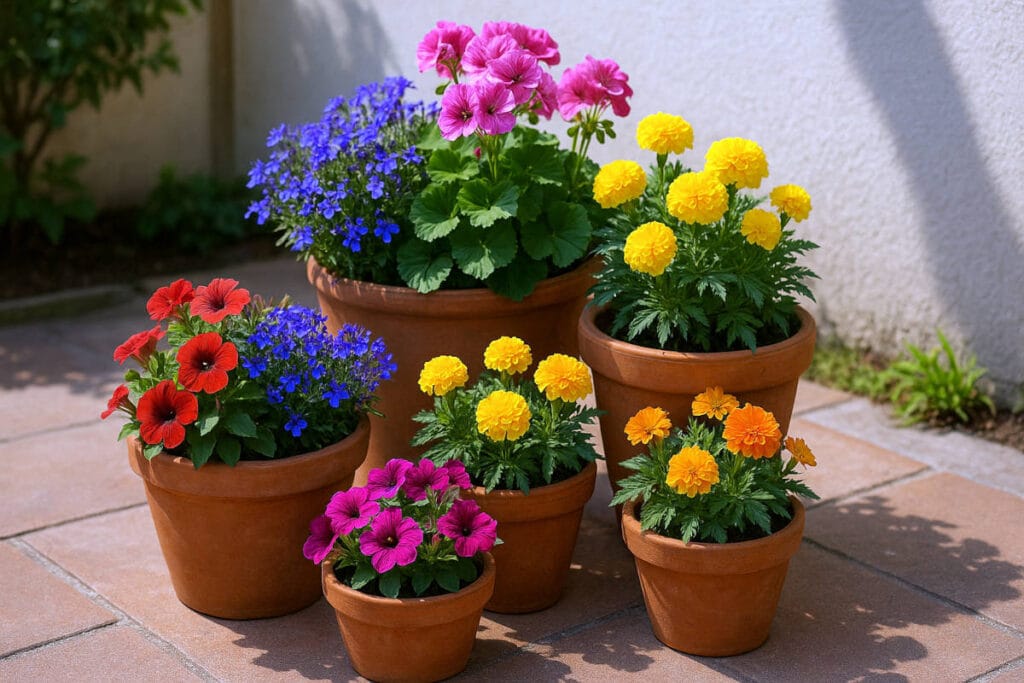
If your outdoor space feels a little dull, this is one of the easiest container gardening ideas to brighten it up. Terracotta pots are a classic for a reason. They’re affordable, easy to find, and their warm earthy color makes flower colors pop.
For a show-stopping display, try mixing plants that bloom in different colors and heights. Think petunias spilling over the sides, bright marigolds sitting in the middle, and taller geraniums standing proud in the back. Want a little texture? Add some trailing lobelias with their delicate purple-blue flowers.
Here’s a tip: group several pots of different sizes together in one spot. Place the tallest ones in the back and shorter ones upfront. This creates depth and makes the whole arrangement look intentional and full.
Also, make sure you’re placing these pots somewhere with plenty of sunlight. Most flowering annuals love at least 6 hours of sun a day. And don’t forget drainage! Terracotta is porous, but you still need proper holes at the bottom of each pot to avoid soggy roots.
This idea is perfect for patios, front steps, or even lining a walkway. Instant color. Instant charm.
You may also like:
- Brazilian Wood Plant Care: How to Grow It in Soil or Water Indoors
- Top 7 Pet Roses That Won’t Harm Your Dog or Cat
2. Vertical Herb Garden Using Hanging Buckets
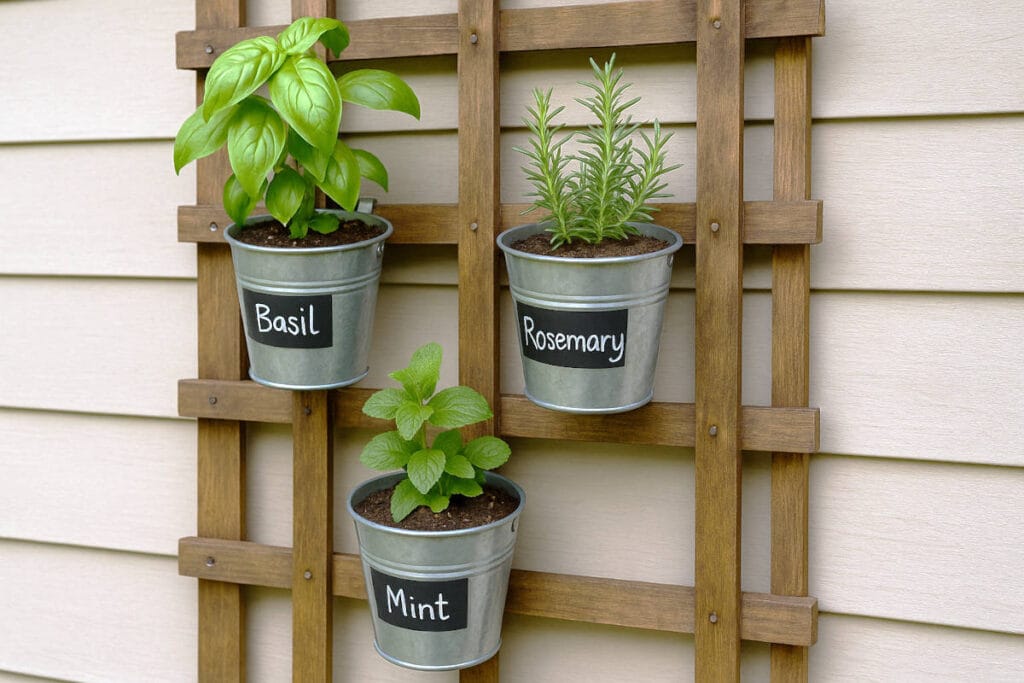
Short on floor space? No worries. Going vertical is one of the smartest container gardening ideas out there, especially for herbs. Plus, it looks super cool.
Here’s how it works: grab a few small metal buckets (or any lightweight containers you like), add drainage holes if they don’t already have them, and hang them on a wooden trellis, wall-mounted rack, or even a simple ladder leaned against a wall. It’s low-cost and makes a big visual impact.
Now, let’s talk herbs. Basil, parsley, rosemary, thyme, and mint all do great in containers like this. Just make sure each plant gets enough light—at least 4 to 6 hours of sun per day works best for most herbs.
One of the best parts? Harvesting is a breeze. Step out to your balcony or patio, snip what you need, and toss it straight into your cooking. No more sad wilted herbs from the grocery store.
If you want to add extra charm, label each bucket with chalkboard paint or cute little tags. Not only is it practical, but it gives your garden that Pinterest-worthy look.
This vertical herb garden setup is a fun, space-saving way to grow fresh flavors right at home.
You may also like:
3. Succulent Arrangement in a Shallow Ceramic Bowl
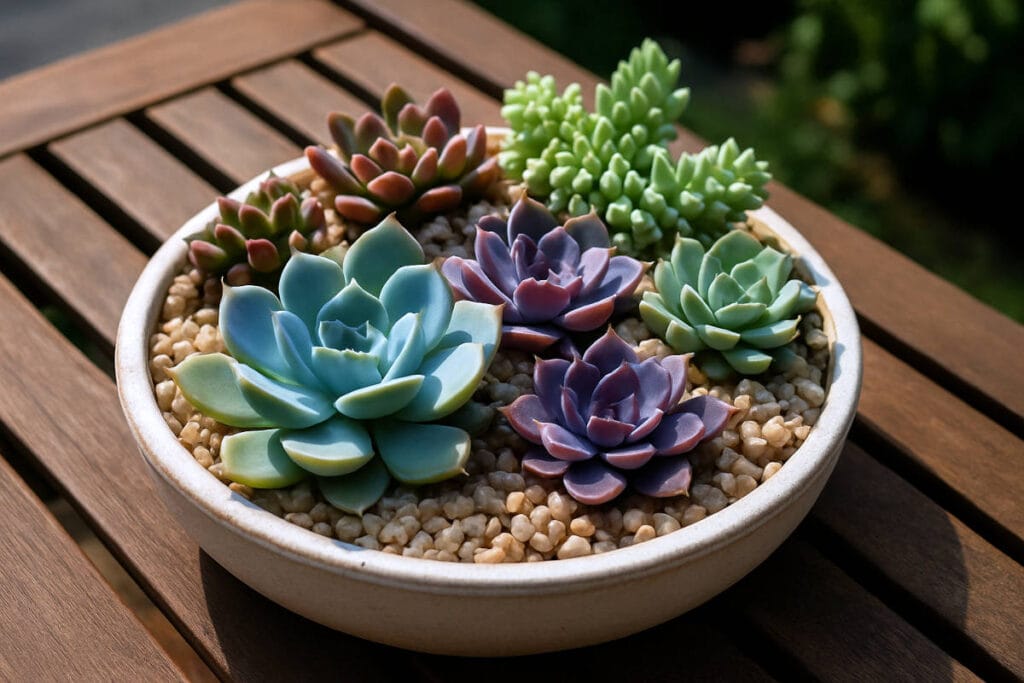
If you’re after something low-maintenance but still super eye-catching, a succulent bowl is a fantastic container gardening idea. Succulents don’t ask for much, and they look great with minimal effort. Win-win.
Start with a wide, shallow ceramic bowl—something with good drainage holes at the bottom. Fill it with a cactus or succulent potting mix. Then, get creative with plant selection. Mix textures and colors: maybe a blue-green echeveria, a spiky haworthia, and some trailing string-of-pearls. Want a pop of color? Throw in a purple-tinted sedum or a kalanchoe.
One tip: don’t cram them too close together. Give each plant a bit of breathing room. Succulents like airflow around their leaves to avoid rot. Plus, leaving some space lets them grow over time and fill in naturally.
Place your bowl where it gets bright, indirect sunlight—near a sunny window, a covered patio table, or even as a centerpiece for your outdoor dining area. And go easy on the watering. Let the soil dry out completely before giving them another drink.
Another fun idea? Top the soil with decorative gravel or tiny pebbles. It gives your arrangement a polished, magazine-worthy look.
So yeah, if you want style without the stress, a succulent bowl is hard to beat.
You may also like:
4. Edible Container Garden – Salad Greens and Cherry Tomatoes
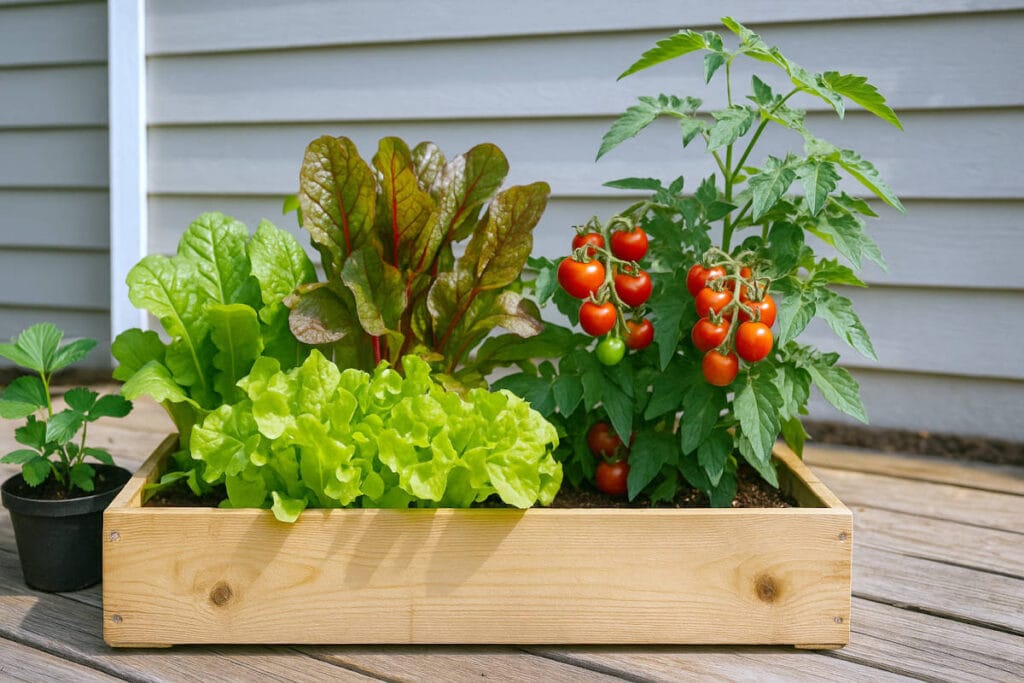
If you’ve ever dreamed of picking fresh salad ingredients just steps from your kitchen, this container gardening idea’s for you. You don’t need a huge vegetable plot. Just one or two good-sized planters and a sunny spot.
Start with leafy greens like lettuce, spinach, or arugula. They grow quickly and don’t need super deep containers. A rectangular planter works great here. Fill it with a rich potting mix, and you’ll see sprouts in no time.
For the tomatoes, choose compact or dwarf varieties, like cherry or grape tomatoes. They’re perfect for containers. One sturdy stake or a small tomato cage will help support the plant as it grows. Tomatoes love sun, so aim for at least 6-8 hours of direct light a day.
Here’s a fun trick: mix in some edible flowers like nasturtiums. They’re colorful, attract pollinators, and you can toss the petals right into your salad.
Water regularly, especially during hot days—veggies in containers dry out faster than those in garden beds. And don’t forget to feed your plants with a balanced, water-soluble fertilizer every couple of weeks.
The best part? That feeling of satisfaction when you head outside, snip some fresh lettuce, grab a couple of cherry tomatoes, and toss together a salad that’s literally garden-to-table.
You may also like:
5. Recycled Containers – Flowers in Old Wooden Crates
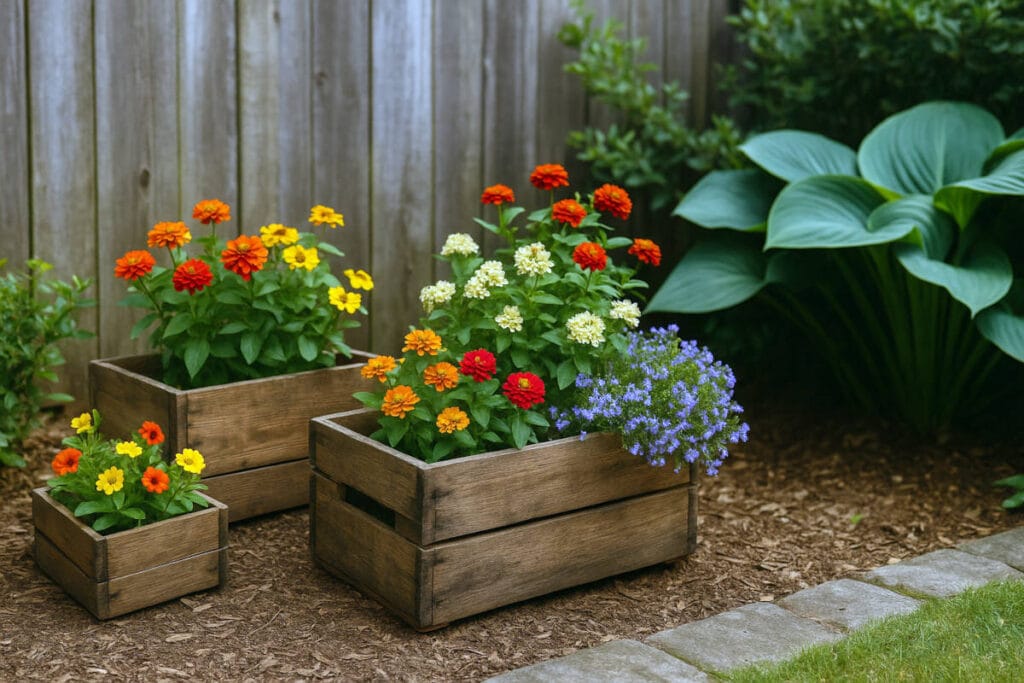
Got an old wooden crate lying around? Don’t toss it—turn it into a flower planter! This is one of those container gardening ideas that proves you don’t need fancy pots to create something beautiful.
Old fruit crates, vintage wine boxes, or even wooden shipping containers make excellent planters. They add rustic charm and give your outdoor space that cozy, farmhouse feel.
Just line the inside with landscaping fabric or a heavy-duty plastic bag (poke some drainage holes at the bottom), fill it with potting soil, and you’re ready to plant.
When it comes to flowers, go for a mix that’ll spill and trail over the edges. Think colorful zinnias, cheerful pansies, bright nasturtiums, or trailing petunias. You can even mix in some herbs like thyme or oregano for a little extra texture—and fragrance.
Want a quick styling tip? Group two or three crates at different angles for a layered look. Prop one on its side, let flowers spill out like a little cascade. It’s casual, charming, and doesn’t cost much.
Plus, using recycled containers is a nice eco-friendly touch that makes your garden a bit more sustainable. Bonus points if the wood already looks weathered—it’ll just add more character.
You may also like:
6. Dramatic Foliage Plants in Large Black Planters
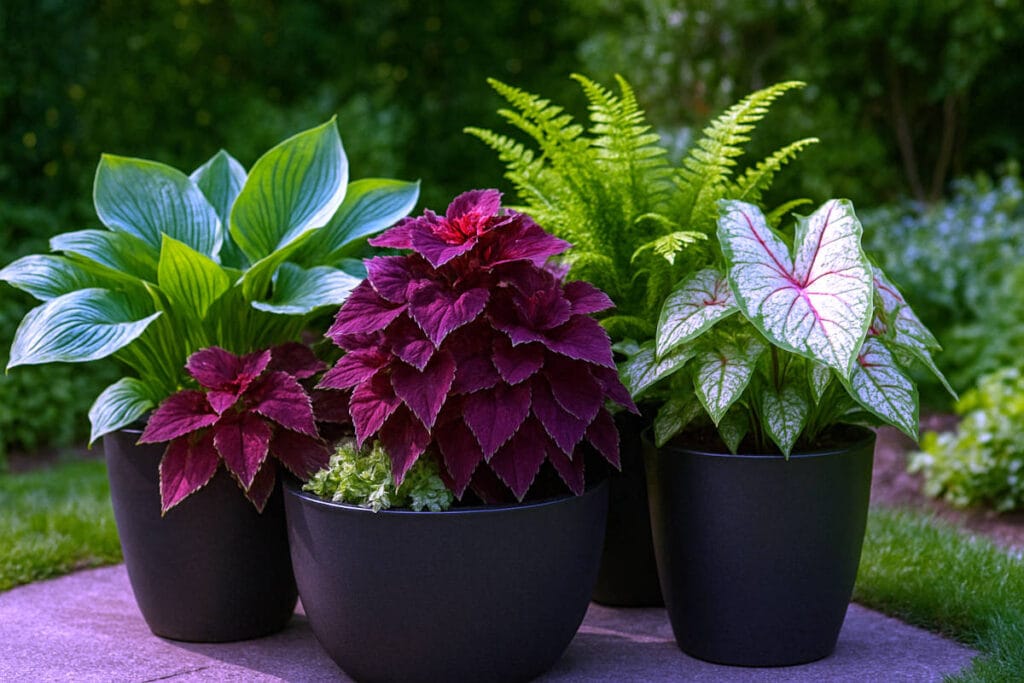
If you want your garden space to have a bold, modern feel, large black planters filled with dramatic foliage are the way to go. This is one of those container gardening ideas that’s all about texture, contrast, and structure—not just flowers.
Think big, leafy plants like hostas, coleus, and ferns. These plants don’t rely on bright blooms to grab attention. Instead, their oversized leaves, deep colors, and interesting shapes do all the work. Coleus comes in incredible shades—burgundy, lime green, even pink variegations—while ferns add softness and movement.
Black planters are a great backdrop because they make the greens and purples pop. Plus, they work with almost any outdoor design style, whether you’ve got a sleek urban patio or a shaded woodland corner in your backyard.
For best results, choose plants with similar light and water needs. Most foliage combos like this will do well in part shade or full shade, but double-check your plant labels just in case.
Here’s a style tip: use planters of varying heights. Place a tall one in the back with something upright (like ornamental grasses), and shorter planters with spreading foliage in front. This creates a layered, lush effect without much effort.
Maintenance is simple too. Most foliage plants are pretty forgiving as long as you water them regularly and don’t let them dry out completely.
So if flowers aren’t your thing (or you just want a change), go big with foliage and let the leaves steal the show.
You may also like:
7. Mediterranean Container Garden with Lavender and Olive Tree
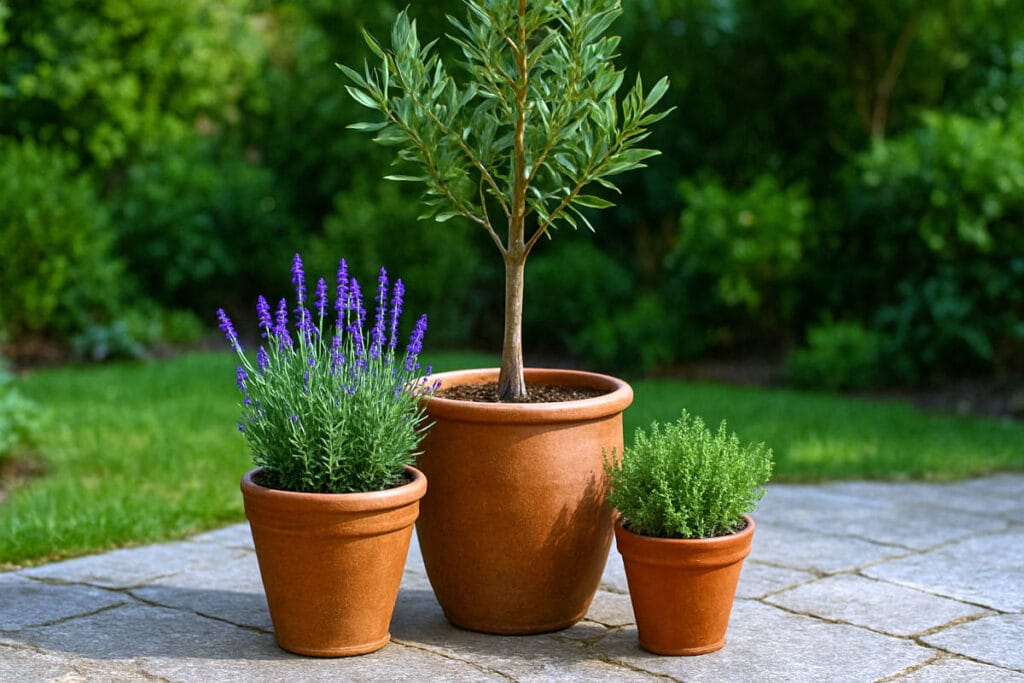
Want to bring a little slice of the Mediterranean to your backyard or patio? This container gardening idea makes it easy. All you need is one large planter for a dwarf olive tree and a couple of smaller pots for lavender and maybe some thyme.
Olive trees are surprisingly well-suited for containers. They love full sun and don’t mind drier soil conditions. Just make sure you choose a variety that stays small and compact, like a dwarf or patio olive tree. Plant it in a large terracotta or stone planter for that authentic Mediterranean feel.
Now for the lavender. Its silver-green leaves and soft purple blooms not only look stunning but also smell amazing. Plus, it’s a magnet for pollinators like bees and butterflies.
Arrange your containers together on a stone patio or deck, and let the sun do the rest. These plants thrive in hot, sunny spots, making them perfect for areas with plenty of afternoon light.
If you want to take it a step further, you can add a few decorative touches—maybe some smooth river stones on top of the soil or a small rustic garden lantern nearby.
Water the olive tree when the top few inches of soil feel dry, and prune lightly to keep its shape. Lavender prefers to dry out a bit between waterings, so don’t overdo it.
This setup looks beautiful and brings a relaxed, sun-soaked vibe to your space, without the need for a plane ticket.
You may also like:
8. Cascading Plants in Tall Planters
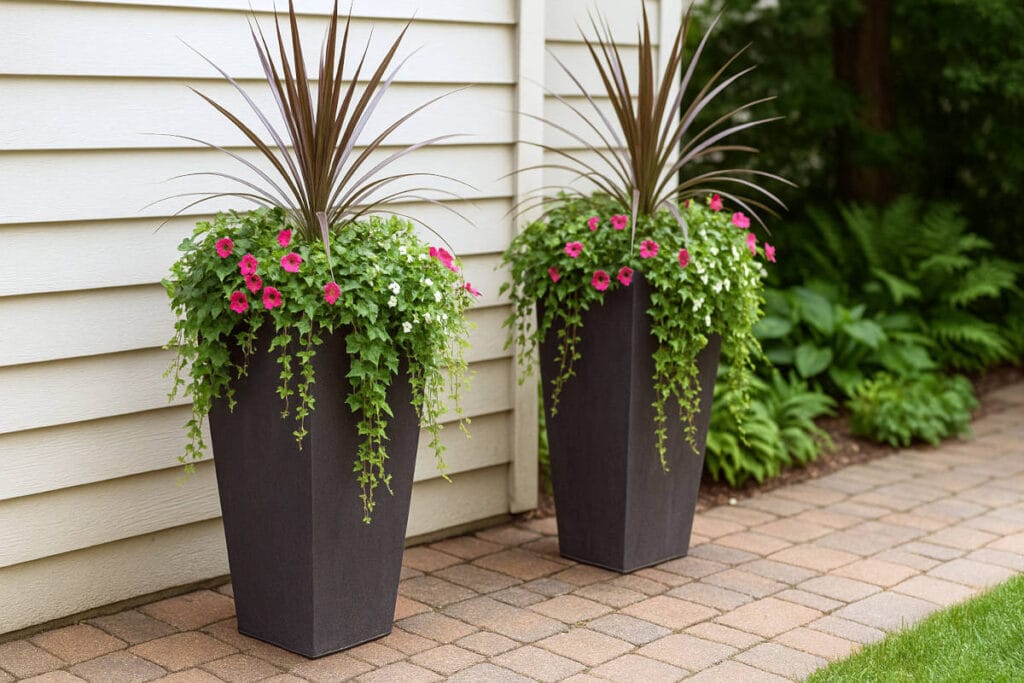
If you’re looking to add height, drama, and a sense of movement to your garden space, tall planters with cascading plants are a fantastic choice. This is one of those container gardening ideas that instantly draws the eye.
Start with tall, narrow containers, something sleek and modern, or even classic urn-style planters if that’s more your vibe. The key here is verticality. Once you’ve got your planters, fill them with plants that love to spill and trail.
Good options? English ivy, sweet potato vine, bacopa, or even trailing petunias for a pop of color. For more texture, mix in something upright like dracaena spikes or ornamental grasses in the center. This creates that popular “thriller, filler, spiller” look without much effort.
Place your tall planters at entryways, next to staircases, or along walkways. They work great for framing doors or creating a soft privacy screen in small outdoor spaces.
And don’t forget: tall containers can dry out faster, especially at the top. Water thoroughly and check soil moisture often, especially during hot spells.
Another plus? Cascading plants help soften hard landscaping features like brick walls or metal railings. So if your space feels a little too “concrete jungle,” this is a great way to bring in something more organic and flowing.
You may also like:
9. Tropical Look – Ferns and Caladiums in Colorful Pots
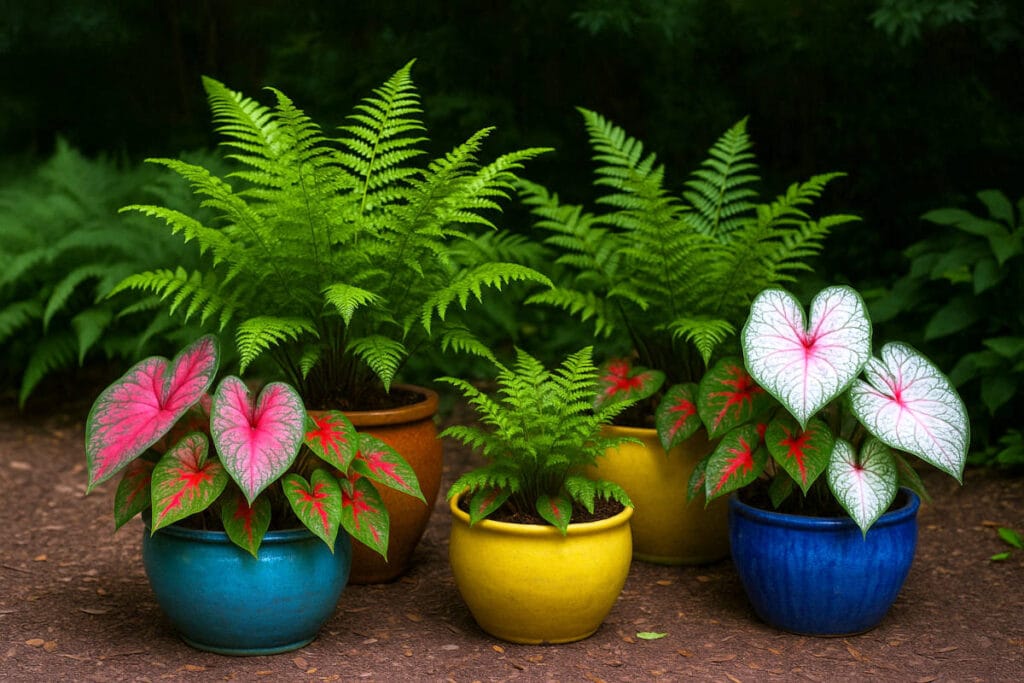
If you want instant tropical vibes—even in a shady corner of your yard—this is one of the easiest container gardening ideas to pull off. It’s all about bold foliage and bright colors.
Start with colorful ceramic pots—think deep blues, sunny yellows, or vibrant greens. The more color, the better. Place them at different heights for a layered look. You could even use plant stands or bricks to give some pots a little lift.
For plants, go with ferns for lush, feathery texture and caladiums for a pop of dramatic color. Caladium leaves come in amazing shades of red, pink, white, and green—perfect for making a statement. These plants thrive in partial to full shade, making them great for spots that don’t get a ton of direct sun.
Want to make the whole display even more eye-catching? Mix in some coleus or begonias with variegated leaves for extra pattern and color contrast.
One thing to remember: keep the soil consistently moist. Both ferns and caladiums hate drying out completely. If you’re worried about overwatering, make sure your containers have good drainage holes.
Place this setup near your front door, on a shaded patio, or even under a tree where nothing else seems to grow. It’s an easy way to create a mini tropical escape right at home.
You may also like:
10. Balcony Garden with Mixed Vegetables in Containers
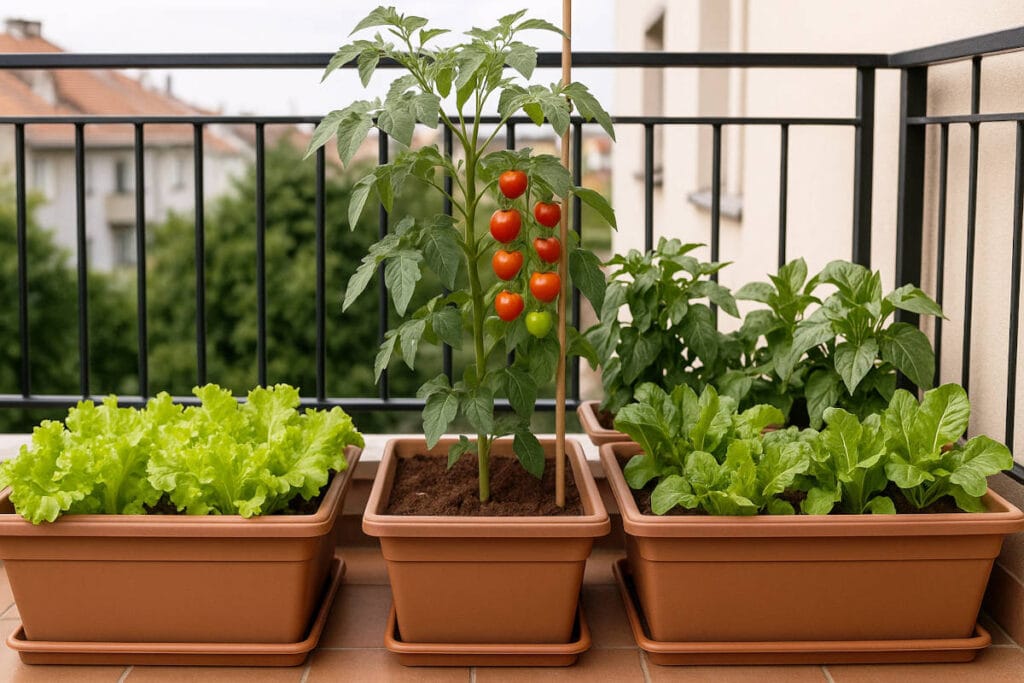
No backyard? No problem! If you’ve got a balcony with a bit of sun, you’ve got space for a productive vegetable garden. Long, rectangular planters are perfect for maximizing every inch of available space.
Start with leafy greens like lettuce and spinach. They don’t need deep soil, and they grow fast. Next, add compact pepper plants and dwarf tomato varieties like cherry or grape tomatoes. These do well in containers and won’t take over your whole balcony.
Want an extra touch of charm? Tuck in a few marigolds or nasturtiums at the edges. Not only do they add color, but they also help repel pests naturally.
If your balcony railing gets plenty of sun (at least 6 hours a day), line your planters right along it. This gives your veggies all the light they crave while keeping the floor space clear.
Pro tip: Install a simple drip irrigation kit or use self-watering containers if you’re busy or tend to forget watering. Container veggies dry out fast, especially in summer heat.
And don’t forget support! Use small tomato cages, bamboo stakes, or trellises for climbing plants. Keeping things vertical makes your space feel lush without feeling crowded.
The best part? By mid-summer, you’ll be stepping outside for fresh salads and homegrown toppings. Pretty cool for a small urban space, right?
You may also like:
11. Seasonal Container – Autumn Theme with Mums and Pumpkins
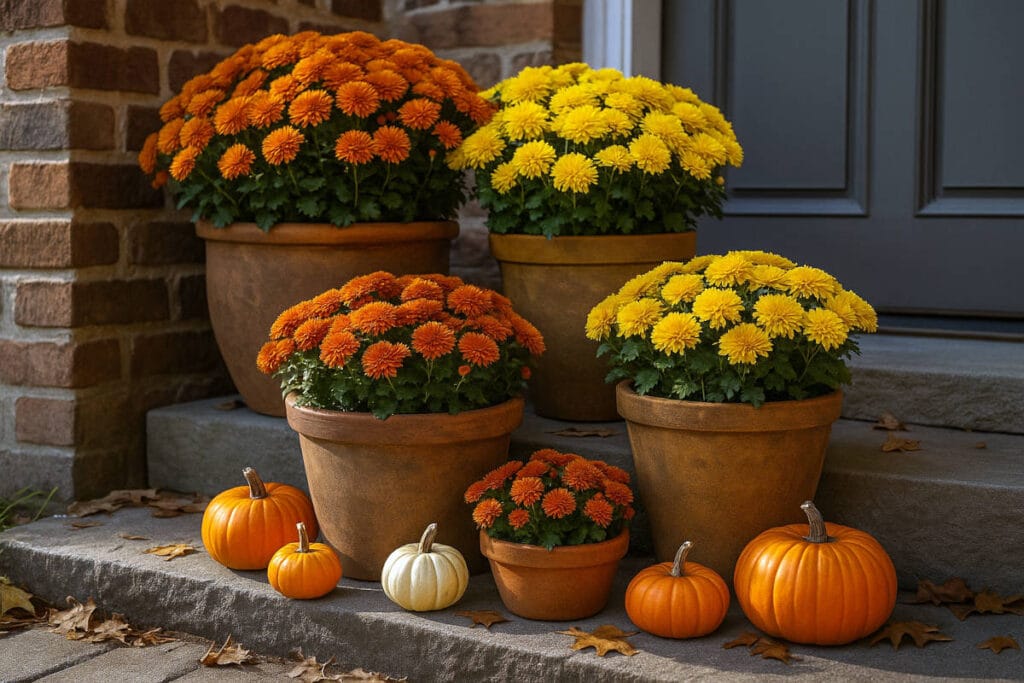
When autumn rolls around, it’s time to switch up your container gardening ideas for something warm and seasonal. One of the easiest (and most visually satisfying) ways to decorate is with pots of colorful mums paired with small pumpkins.
Start with chrysanthemums in classic fall shades like orange, yellow, deep red, or burgundy. These plants love cooler temperatures and can handle being outdoors well into the season.
Next, scatter mini pumpkins or decorative gourds around the base of your pots. You don’t even need to plant them—just set them directly on the ground or steps around your containers for instant charm.
If you want to take it up a notch, add in a few pots with ornamental grasses or kale for texture and color contrast.
The best spots for this setup? Front porches, entryway steps, or patios—anywhere that gives visitors a cheerful autumn welcome. Bonus points if you toss a few fallen leaves around for that extra seasonal touch.
One tip: mums need regular watering, especially when kept in containers. Let them dry out too much and they’ll fade fast. Keep the soil moist but not soggy.
This fall display is beautiful, low maintenance, and easy to pull together in an afternoon. Seasonal decorating? Done.
You may also like:
Choosing the Right Containers for Your Space
Let’s talk pots and planters for a second. Looks matter, but the size, material, and even color of your containers can affect how well your plants grow.
First thing: size matters. Tiny pots might look cute, but if you’re planting something with deep roots, like tomatoes or small shrubs, you’ll need room for those roots to spread. Bigger containers also hold moisture longer, meaning you won’t have to water as often.
Now, let’s get into materials:
- Terracotta: Classic and breathable, but dries out quickly. Great for Mediterranean-style plants like lavender.
- Ceramic: Pretty and comes in tons of colors. Just watch the weight—they get heavy fast.
- Plastic: Lightweight and budget-friendly. Plus, it holds moisture better, making it a solid choice for beginners.
- Wood: Rustic and charming. Works great for larger setups, like vegetable boxes, but it will eventually rot if not treated properly.
- Metal: Trendy but heats up fast in full sun. Good for decorative spots, but monitor soil moisture carefully.
Drainage is non-negotiable. Whatever container you choose, make sure there’s a hole (or several) at the bottom. No one wants root rot.
Another tip: consider your space and style. Go for tall, narrow containers if you’re short on floor space. Use matching pots for a cohesive look, or mix-and-match for something more eclectic and fun.
Choosing the right containers upfront means less stress later and happier, healthier plants.
You may also like:
Tips for Successful Container Gardening
Okay, you’ve got your containers and picked your plants. Now let’s make sure they actually survive—and thrive. Container gardening is pretty forgiving, but a few smart habits make a big difference.
Soil matters.
Skip the dirt from your backyard. Use a high-quality potting mix made specifically for containers. It’s lighter, drains better, and gives roots the oxygen they need. If you’re planting veggies or herbs, look for mixes labeled for edibles.
Water like you mean it… but don’t drown them.
Plants in containers dry out faster than ones in the ground. In hot weather? You might need to water daily. But here’s the thing: soggy soil is just as bad as dry soil. Stick your finger in the dirt. If the top inch feels dry, it’s time to water.
Feed your plants.
Nutrients in container soil don’t last forever. Use a liquid fertilizer every couple of weeks, especially for flowering plants and veggies. For herbs, go lighter, because too much fertilizer can reduce their flavor.
Light makes or breaks it.
Read your plant labels. Full sun means at least 6 hours of direct sunlight. Partial shade? About 3-4 hours. If your balcony or patio doesn’t get much light, stick with shade-tolerant plants like ferns or caladiums.
Keep an eye on pests.
Just because it’s in a pot doesn’t mean it’s safe from bugs. Aphids, spider mites, and caterpillars still find their way in. A quick blast of water or some insecticidal soap usually does the trick.
A little attention goes a long way. Check on your container garden daily—or at least every couple of days—and you’ll catch problems before they turn into disasters.
With the container ideas above, you can see that gardening is possible no matter where you live or how much room you’ve got.
By choosing the right plants, picking suitable containers, and following a few simple care tips, you’ll be well on your way to a thriving container garden. It’s one of the easiest and most rewarding ways to enjoy gardening, even if all you have is a balcony or a sunny doorstep.
So go ahead. Grab a pot (or some), get your hands a little dirty, and start planting. Your home will look greener in no time.
Want to grow tomatoes in containers? If you’re curious about growing your own fresh tomatoes, don’t miss our complete, step-by-step guide: How to Grow Tomato Plants in Pots: The Ultimate Guide.
FAQ – Container Gardening Ideas
1. What are the best plants for container gardening?
Some of the easiest and most popular choices include herbs like basil and rosemary, vegetables like tomatoes and lettuce, flowering plants like petunias and marigolds, and foliage plants like ferns and coleus.
2. How often should I water my container plants?
It depends on the plant and the weather, but most container gardens need watering once a day during hot months. Always check the soil moisture—if the top inch feels dry, it’s time to water.
3. Do all containers need drainage holes?
Yes. Proper drainage is essential to prevent root rot. If your container doesn’t have holes, drill some or choose a different pot.
4. What’s the best soil for container gardening?
A high-quality potting mix designed for containers is your best bet. Avoid using garden soil—it’s too heavy and can compact easily.
5. Can I grow vegetables in containers?
Absolutely! Many vegetables thrive in pots, including tomatoes, peppers, lettuce, spinach, and herbs. Just make sure your containers are large enough for root growth.
6. Where should I place my container garden?
Place your containers based on the light needs of your plants. Full sun for most vegetables and flowering plants, partial shade for ferns, caladiums, and some herbs.
7. How do I prevent pests in my container garden?
Inspect your plants regularly. If you spot pests like aphids or spider mites, use insecticidal soap or simply rinse them off with water. Keeping your plants healthy is the best defense.
8. Do I need to fertilize container plants?
Yes. Because nutrients in container soil get depleted quickly, feed your plants with a balanced, water-soluble fertilizer every couple of weeks during the growing season.